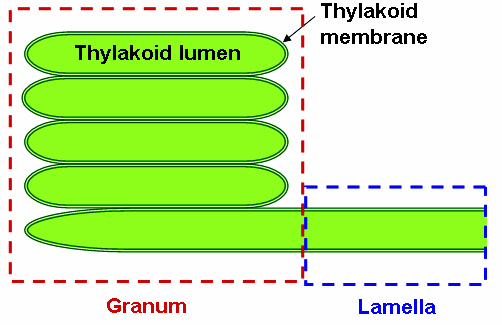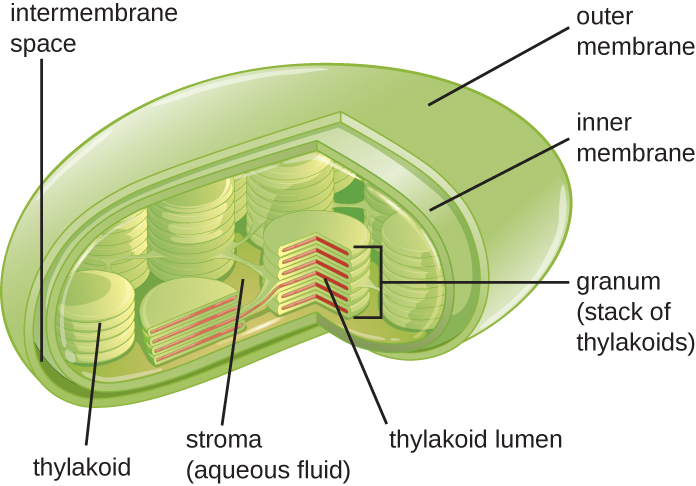Difference Between Grana and Thylakoid
Key Difference – Grana vs Thylakoid
Plant cells, which are eukaryotic in nature, contain different organelles in order to carry out its functions accurately. Chloroplast is a vital organelle in the plant cell and is a membrane bound organelle involved in performing the function of photosynthesis in plants; photosynthesis is the process where plants produce their food and energy by utilizing carbon dioxide, water, solar energy captured by the plant pigment – chlorophyll. Chloroplasts are self-replicating organelles and contain different compartments within the organelle to facilitate its functions. Grana and thylakoids are two components found in chloroplast and are involved in the light reaction of photosynthesis. Thylakoids are membrane bound compartments or disks where the light reaction takes place. Grana are the stacks of these thylakoid disks formed inside the chloroplast. This is the key difference between grana and thylakoids.
CONTENTS
1. Overview and Key Difference
2. What are Grana
3. What is Thylakoid
4. Similarities Between Grana and Thylakoid
5. Side by Side Comparison – Grana vs Thylakoid in Tabular Form
6. Summary
What are Grana?
Grana (singular – Granum) are stacks of membrane disks known as thylakoid membranes, and they are distributed in the stroma of the chloroplast. They are microscopic and can be observed under the light microscope and oval shaped stacks. The grana are connected by lamellae, a membrane that bridges the grana, and also participates in the light reaction process.

Figure 01: Grana of Chloroplast
Organization of thylakoids into grana increases the surface area for light dependent photosynthesis in plants, thereby increasing the efficiency of the process.
What is Thylakoid?
Thylakoids are disk shaped membranous structures which are in the chloroplast stroma and are the main compartments that participate in the light dependent reaction of photosynthesis. They are microscopic and are mainly observed via electron micrography. They contain stores of chlorophyll which capture the solar energy to initiate the light reaction of photosynthesis via photosystems I and II. When light strikes these pigments, they split water and release oxygen through the process of photolysis.

Figure 02: Thylakoids
The electrons released from this reaction hit the photosystem 2, and are transferred to photosystem 1 via electron carriers. The electrons are further excited and are boosted to higher energy states. The electron carrier NADP+ receives the electrons and is reduced to NADPH, creating ATP.
What are the Similarities Between Grana and Thylakoid?
- Grana and thylakoids are located in the chloroplasts stroma of plant cells.
- Both are microscopic structures.
- Both are membranous structures.
- Both structures contain chlorophylls (plant pigments) for photosynthesis.
- Both structures involved in the light reaction of Photosynthesis
What is the Difference Between Grana and Thylakoid?
Grana vs Thylakoid | |
| Grana are the organized stacks of disk shaped membranous structures known as thylakoids located in the stroma and involved in light dependent reactions of photosynthesis. | Thylakoids are the individual membranous disks containing chlorophyll located in the stroma, responsible for light dependent reactions of photosynthesis. |
| Microscopic Nature | |
| Grana can be observed under the light microscope. | Thylakoids can be observed under the electron microscope. |
| Involvement of Lamelle | |
| Lamellae join the adjacent grana embedded in the stroma. | Lamellae do not join individual adjacent thylakoids. |
| Surface Area for Photosynthesis | |
| Grana increases the surface area for photosynthesis | Individual thylakoids have a lesser surface area for the process of photosynthesis in comparison to the stacked structure grana. |
Summary – Grana vs Thylakoid
Photosynthesis is a vital process for maintaining the energy flow in organisms via food chains. It is the only independent process in which carbon dioxide can be converted to glucose and energy. Chloroplasts are the structural sites of photosynthesis, where sunlight is converted into food by plants. This process is carried out in two main ways: the light dependent reaction and the light independent or the dark reaction. Grana are thylakoids are two structures in chloroplasts which are involved in photosynthesis. Thylakoids are the number of flattened sacs inside a chloroplast, bound by pigmented membranes on which the light reactions of photosynthesis take place. Grana are the stacks of thylakoids organized inside the stroma to increase the surface area for light dependent photosynthesis. Light dependent reactions of photosynthesis mainly occur in thylakoid membranes. This is the difference between grana and thylakoid.
Download PDF Version of Grana vs Thylakoid
You can download PDF version of this article and use it for offline purposes as per citation note. Please download PDF version here Difference Between Grana and Thylakoid.
References:
1. Minami, E, and A Watanabe. “Thylakoid membranes: the translational site of chloroplast DNA-Regulated thylakoid polypeptides.” Archives of biochemistry and biophysics., U.S. National Library of Medicine, Dec. 1984. Available here. Accessed 16 Aug. 2017.
2. “What is Granum? – Definition & Function.” Study.com, n.p. Web. Available here. Accessed 16 Aug. 2017.
3. “Thylakoids: Definition & Functions.” Study.com, n.p. Web. Available here. Accessed 16 Aug. 2017.
Image Courtesy:
1. “Chloroplast granum diagram” by BlueRidgeKitties (CC BY 2.0) via Flickr
2. “OSC Microbio 03 04 Chloroplast” By CNX OpenStax – (CC BY 4.0) via Commons Wikimedia
ncG1vNJzZmivp6x7pbXFn5yrnZ6YsqOx07CcnqZemLyue8OinZ%2Bdopq7pLGMm5ytr5Wau26z0ZqlmmWRo7FuwtJmq6GxnJa4sLXDaA%3D%3D